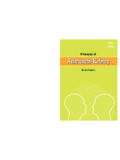Transcription of COMMONEST ABBREVIATIONS, SIGNS, ETC
1 COMMONEST ABBREVIATIONS, SIGNS, ETC. USED IN THE APPARATUS TO A CLASSICAL TEXT Karl Maurer, Department of Classics, 215 Carpenter Hall, The University of Dallas, 1845 East Northgate Drive, Irving TX 75062 When I was in graduate school and first starting to use an apparatus criticus, I could nowhere find any list explaining common abbreviations and could often only guess at what they meant, and this was often maddening. So for students I here offer a small list; it is certainly very incomplete, but includes all the abbreviations that occur to me. I include also some whole words, which in textual criticism have a special pregnant meaning (see ex ). I am much indebted to Scott Scullion of Worcester College, Oxford for additions and several corrections. When a Latin adjective is neuter -- alia or alterum -- it normally agrees with neuter verba or verbum that we supply in thought.
2 A Latin plural noun or adj. is represented by a double consonant; so vet. cod. = vetus codex, vett. codd. = veteres codices. A B C (etc.) = the signs (sigla) of the capital MSS , the most important MSS, usually described in the preface, & identified in a list that precedes the text. A B: C = the capital MSS A and B have and C has . ( : separates the readings). But often a MS (in older editions, any; in recent editions, a rarely used MS, too unimportant to have a siglum) is represented not by a siglum but by an abbreviation of its name, Laur. = (codex) Laur(entianus), or Vat. 226 = codex Vaticanus 226. a b c (etc.) = either (a) less important MSS, or else (b) families of MSS. (In a family , all its MSS tend to have the same or similar errors; so they seem descended from a common exemplar.)
3 (etc.) = (usually) lost hyparchetypes (alias proarchetypes , alias proexemplars ), conjectured lost MSS, from which the best of ours seem to derive. So perhaps A B D descend from , F M from -- etc. (But sometimes--esp. in older editions--these Greek letters are also used for manuscript families ; or sometimes even for extant MSS. You have to read the editor s preface.) A1 A2 A3 (etc.) = the main copyist s hand in A, a 2nd hand in A, a 3rd hand in A. Such a 2nd or 3rd hand is usually that of a corrector; so A2 or A3 is sometimes called A1 A2 A3 (etc.) Subscript numbers usually mean not mere correctors but actual copyists when there were more than one. one can discern that A1 copied everything till a certain page; then A2 took over; etc. Af Bfm (etc.) Superscript letters often refer to scholia ( ancient notes on the passage: see below, ), and often they are named after the MSS in which they appear in their fullest form.
4 So codd.: Af might mean that in this place all the MSS (including A) read , but in A, the f scholia ( the ancient notes which F has in their fullest form) quote our passage and have . (But superscript letters often have quite other meanings -- you have to read the editor s list of sigla carefully.) abiud. = abiudicavit = has reassigned . haec Euripidi abiud. Page = Page reassigned these (words) from Euripides to someone else; in Page s judgement Euripides did not write them. = ante corr. = ante correctionem = before correction; ] A means: all copies (including A) have , but A has before correction . ad = at or on . Usually used in citing ancient or modern commentary; so Porfyrio ad Hor. = see Porfyrio s commentary on Horace, Ode ; there Porfyrio quotes our passage.
5 Add. = addidit = added (tends to mean the same as suppl. , on which see below) addub. = addubitavit = has doubted al. = alii or = alibi = elsewhere alii = others, (usually) other editors, or other manuscripts. alii alia = here some (conjecture) some (words); others, other (words) , often written when no conjecture seems right. alterum = the other = the second of the two s . (For example, see under del. For its opposite see prius .) an | perhaps , introducing the editor s tentative suggestion ante = before (both in time and space), ante corr. = before correction. ap. = apud = at . See ad = ante rasuram, before erasure . ca. = circa = about, approximately . cens. = censuit (pl. censuerunt) = judged , considered . cett. = ceteri codices, the other manuscripts cf. = confer = compare. Cf. is often followed by the number of a passage, in which you will find a usage similar to that which the editor posits here.
6 (In old editions you sometimes see cp. = compare ) ci. = cj. = conj. ( ) cl. = coll. cod(d). = codex (codices) = mss. = manuscripts. codd. = all MSS have this, but it seems wrong. Cf. emend. coll. = collato codice (pl. collatis codicibus) = lit. with that MS collated ( after collating that MS); or else = collato loco | lectione = lit. with that place | reading compared ( after comparing that place or reading with this one -- for an example, see under def. ). conj. = conicit (coniecit, conieci) = conjectures ( conjectured , I conjecture ). So te conj. Wil. = Wilamowitz conjectured te . Or conieci = I have conjectured ( is my conjecture ). cont. = continuavit (pl. continuaverunt) = continued (to) 10-12 El. cont. Smith = Unlike others, Smith thinks that Electra (who has been speaking up to verse 9) continues to verse 12.
7 Cont. = contulit = compared. corr. = correctio = correction. damn. = damnavit = condemned , thought corrupt. deest or pl. desunt = (this word) is missing, [these words] are missing). deest L = is missing in L. (Compare om. Om. is normally used when the modern editor feels certain that the omission was made in error; deest , when he feels less certain of this. Deest and desunt are used especially for inscriptions and papyri; see under ll. ) Deest sometimes indicates that the evidence of a papyrus is unavailable for this letter/word/passage (because the papyrus is damaged or its reading for some other reason is illegible) def. = defendit = defends, or (pf.) has defended. def. Hude coll. = Hude defends here, comparing its use at with its use here. del. = delevit = deleted , or delevi = I have deleted , alterum del. Wil.
8 = Wil. deleted the 2nd . (For more about this see under secl. ) dett. = deteriores (codices) = inferior MSS. dist. = distinxit = has punctuated. Often refers to a period; post dist. Hude = Hude punctuates with a full stop after . dub. = dubius = doubtful or dubitanter = doubtfully. e or ex = from or on the basis of . ] Leutsch e schol. = the MSS have . Leutsch, unlike us, emends that to on the basis of the scholium here ( because the scholium has, or implies, that reading here). Or - ] - conj. Snell e Pae. = Snell conjectures that - , given by the MSS, is a corruption of the very rare form - , which occurs in Paean 12, line 9 edd. = editores = editors. edd. vett. = editores veteres = old (usually 15th or 16th-century, and Italian) editors or editions.
9 So alterum del. = earlier editors deleted the 2nd . (These edd. vett. are sometimes cited because they may have used good MSS now lost.) ed. pr. = editio princeps = the first printed edition. em. = emend. = emendavit (emendat) = emended (emends). Used when all the MSS are plainly wrong (see codd. ). in his text an editor prints .., and in his apparatus says: ] codd. (emend. Wil.) = the best MSS have ; the which I print is an emendation, probably right, by Wilamowitz . exp. = expunxit: has deleted. fere = almost or in general fin. or ad fin. or sub fin. = at or towards the end (of the line, passage, page, etc.) fort. or fors. = fortasse or forsan = perhaps; conceivably. ( the editor stresses that he is guessing.) fr. = fragmentum = fragment gl. = glossa = gloss . or gr. = (pl. ) = (lit.) is written ( are written ) -- applies to variant readings which are labelled as such in the MS itself, usually by this same abbreviation.
10 So ] . 2 means that next to , the second hand in A ( a corrector) has written . (or ), meaning that he has seen that variant reading in another MS. (When the variant is not thus labelled in the MS itself, our apparatus has not . but , for which see below.) Often the nature of these additions is discussed in the modern editor s Preface. = hunc versum = this verse iam = already , usually with the name of a scholar whose emendation was already close to the truth (cf. praeeunte below). = in margine (see marg. ) indic. = indicavit (pl. indicaverunt) = indicated , especially of a lacuna, post h. v. lac. indic. Smith = Smith marked a lacuna after this verse inf. = infra = below . inf. = inferior = inferior , lower, later; or = infra = below . init. = initium or ad initium = near the beginning (of the line, of the word, etc.)





